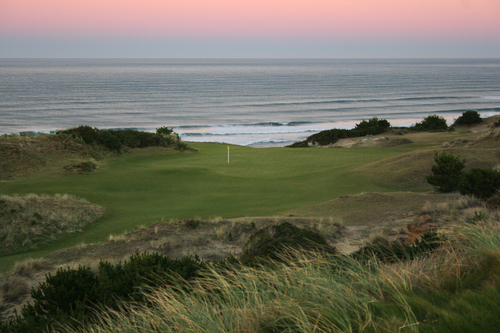Philosophy & inspiration
Two great things happened to Matt after he passed his driving exam at the age of 16: his grandmother sold him her 1974 Dodge Dart and he bought his first set of used golf clubs. For the remainder of high school he would spend much of his free time driving the back roads of New Jersey and hacking away on daily fee and municipal golf courses, attempting to unlock golf's secrets while also trying to teach himself, through trial and error, a proper golf swing.
These formative years gave Matt an appreciation for affordable and accessible public golf facilities because, without them, a lifelong love of the game and a career in the golf industry could never have happened.
In the decades that have followed, Matt has had the opportunity to see many golf courses throughout the U.K., Europe, and the United States and he now has a much better understanding of what makes for an outstanding and memorable golf experience.
Matt may still be a very average golfer but he hopes that he can share some of his experience to design golf courses that will get the next generation of golfers hooked on the game.
The following are Matt's most important considerations when designing or upgrading a golf course:
Playability for all skill levels without sacrificing strategic interest;
Working with the natural features of the site to ensure an economical and environmentally responsible construction process;
Courses that are reasonable to maintain and designed with pace of play and affordable greens fees in mind;
Classical design principals, taking inspiration from the great courses and designers, regardless of era.
Things that inspire Matt as a designer (and a golfer): Walking and carrying, bumping and running, old quirk like that found at Prestwick, North Berwick, Cruden Bay, and Lahinch, short grass and wide landing areas, tees within easy walking distance of greens, run-ons and run-offs, micro and macro contouring, hillocks and hollows, ha-ha walls, bunkers that are actually in play (not just "eye candy"), affordable and accessible, playing a round with only one ball, the ‘rub of the green’, fun and quick golf rather than a 5-hour bludgeoning.
LESSONS FROM THE CLASSICS
Click for greater detail
Inspirational Quotes
“Do not let certain standards become an obsession. Quality, not length; interest, not the number of holes; distinction, not the size in the greens - these things are worth striving for.”
“Playing around a golf course is not merely a question of getting around, like traveling over a race course or walking around the block. It’s rather a question of taking nine or eighteen separate and distinct little journeys, each of which presents its own distinct pictures and its own distinct problems as part of the grand tour.”
“...we want our golf courses to make us think. However much we may enjoy whaling the life out of the little white ball, we soon grow tired of playing a golf course that does not give us problems in strategy as well as skill.”
“No real lover of golf with artistic understanding would undertake to measure the quality or fascination of a golf hole by a yard-stick, any more than a critic of poetry would attempt to measure the supreme sentiment expressed in a poem by the same method. One can understand the meter, but one cannot measure the soul expressed. It is absolutely inconceivable.”
“A golf architect must approach each bit of country with an absolute open mind, with no preconceived ideas of what he is going to lay out; the holes have to be found, and the land in its natural state used to its best advantage. Nature can always beat the handiwork of man and to achieve the best and most satisfactory results in laying out a golf course, you must humor nature.”
“The course should so be arranged that the long handicap player or even the absolute beginner should be able to enjoy his round in spite of the fact that he is piling up a big score. In other words, the beginner should not be continually harassed by losing strokes from playing out of sand bunkers. The layout should be so arranged that he loses strokes because he is making wide detours to avoid hazards.”



















